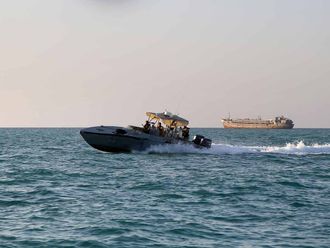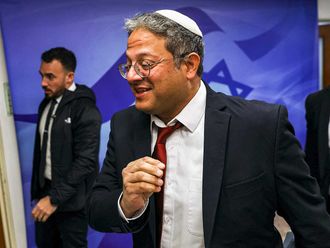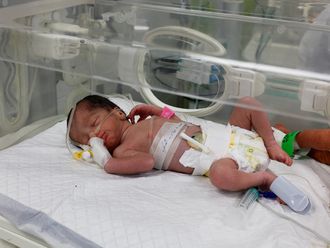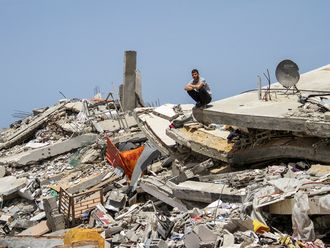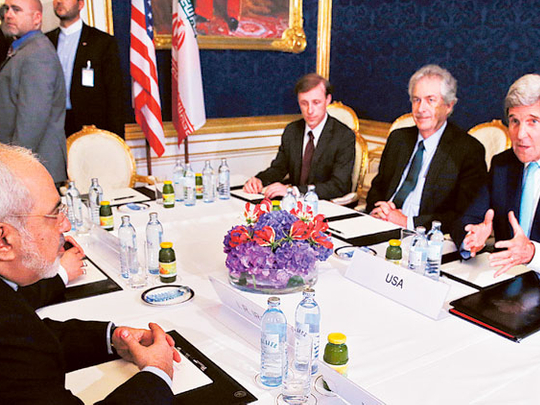
Vienna: Iran’s chief nuclear negotiator, faced with an imminent deadline for an agreement with the West on the future of the country’s nuclear programme, said in an interview Monday that Iran could accept a deal that essentially freezes its capacity to produce nuclear fuel at current levels for several years, provided it is then treated like any other nation with a peaceful nuclear programme.
The proposal, which Iran said was conveyed to the United States and five other world powers during closed-door negotiating sessions in Vienna, would effectively extend a limited series of concessions Iran made in November as part of a temporary deal to get negotiations started on a permanent accord. In return, Iran wants step-by-step relief from sanctions that have substantially weakened its economy.
Offering a rare glimpse into the secret talks, Iran’s foreign minister, Mohammad Javad Zarif, described a proposal that sought to satisfy Washington’s aim to verifiably limit the amount and purity of nuclear fuel that Iran can produce for a still-undetermined number of years. Zarif is also trying to satisfy a military and clerical leadership in Iran that is determined not to dismantle facilities and intent on resuming unhindered production in future years.
“I’m not here to present maximalist positions,” Zarif said in an interview in a 175-year-old neoclassical former palace, now a luxury hotel where the negotiators are living and working. “We’re here to reach an agreement.”
Zarif’s decision to go public with what he called an “innovative proposal” appeared motivated to achieve two goals: to make it harder for the White House to walk away from a deal that would establish intrusive inspections and freeze Iran’s program, but also to offer just enough for both sides to propose extending the talks beyond Sunday, the current deadline.
But while US officials said Zarif was showing a flexibility they had not seen before, his proposal does not address, in its current form, the most central US concern. Because the proposal would leave centrifuges spinning in place, Iran would retain what is known as a “breakout capability” to race for a bomb if it ever decided to produce one. Zarif contended that other elements of his plan would lengthen that period to more than a year, which Secretary of State John Kerry has said is a minimum. US officials are doubtful.
Such arguments are a reminder that this negotiation is taking place on at least two levels: a political discussion that is focused on whether two countries that have been implacable adversaries for more than 30 years can finally reimagine their relationship in the broadest terms, and a technical discussion that is both mind-boggling in its complexity and mired in distrust.
In specific terms, Iran will press for the restrictions on its program to be short-lived, perhaps three to seven years; the United States has said that period must be in the “double digits,” meaning at least a decade. After the agreement expired, Iran would be free to produce as much fuel as it wanted as a signatory of the Nuclear Nonproliferation Treaty, as long as it abided by the treaty’s inspection rules.
Moreover, Congress will be looking for sharp, perhaps permanent, limits on Iran’s capability, or even on its development of next-generation centrifuges, in return for lifting US sanctions.
Zarif rejected the concept that Iran would be subject to any permanent limits, and he did not use the word “freeze,” because his proposal would allow the kind of production of low-enriched uranium fuel that Iran has underway, under a temporary accord. But he said, “I can try to work out an agreement where we would maintain our current levels.”
To provide further assurances to the United States and others, he said, Iran would convert most of the nuclear fuel it produces into a form that is impossible to use in a weapon, and forgo the construction of the facility that would be needed for the first step of converting it into bomb-grade fuel.
Asked about his proposals, a senior administration official involved in the talks here, who would not speak on the record, said: “We have consistently said we wouldn’t negotiate in public, and we’re not going to start doing so now. Some of the things described in this interview they have put forward in negotiations. Some have not come up. And on some, they’ve shown more flexibility behind closed doors.’’
US officials said that keeping the 22,000 nuclear centrifuges Iran has in place - slightly less than half of which are operating - creates the risk that in the future Iran could throw out international inspectors and turn the centrifuges back on, much as North Korea did in recent years with another bomb-making technology.
But Zarif’s decision to go public with the proposal in a 45-minute conversation before meeting with Kerry for a second time in two days was clearly tactical. His willingness to move away from Iran’s insistence that it must be free, immediately, to expand its nuclear program may give Kerry room to recommend to President Barack Obama that the negotiations continue, for weeks or months.
Zarif’s plan follows a declaration by Iran’s supreme leader, Ayatollah Ali Khamenei, last week that Iran would not dismantle any of its infrastructure under Western pressure, but would not need a major expansion of its fuel-making facilities for at least five years. That gave Zarif, who is viewed with suspicion by Iran’s military and its clerical leadership, some wiggle room. His proposal for a freeze moves significantly in the direction the United States and the five other nations have been urging, and brings into focus the outlines of a possible deal, though one that would be extraordinarily hard to reach by Sunday.
In the interview, Zarif accused the West of trying sabotage a heavy-water reactor under construction near Arak by altering components of its cooling system, a step he said could have led to an “environmental catastrophe.” But he did not directly blame the United States.
“You know about cyberattacks,” Zarif said, referring to the US- and Israeli-led operation called Olympic Games that blew up roughly 1,000 centrifuges at the Natanz nuclear enrichment plant until it was discovered in 2010. He said a foreign power had tried “to create malfunctions in equipment” purchased for the Arak plant from outside Iran “so that for instance instead of cooling the facility they would have increased the heat in the facility, had we not detected it” in time.
Zarif offered no evidence, and when pressed, he said his own briefings on the subject have been sketchy. Arak has been a known target of Western intelligence because it has the potential to produce weapons-usable plutonium. He said Iranian engineers found what he contended was sabotage before it could create “huge problems.”
The core measure of whether Zarif’s proposal will gain traction focuses on what nuclear experts call “breakout capacity,” the speed at which Iran could produce the fuel for a single nuclear weapon. The US position has been that only by dismantling a large proportion of Iran’s centrifuges can the United States and its European allies extend that time to a year or more.
Zarif combined his proposal of a freeze with an offer to take the nuclear fuel produced by its 9,000 or so working centrifuges and convert it to an oxide form, a way station to being made into nuclear fuel rods. He said Iran would guarantee, during the agreement, not to build the facility needed to convert the oxide back into a gas, the step that would have to precede any effort to enrich it to 90 percent purity, which is what is generally considered bomb-grade.
He clearly signalled that he had some room to negotiate on how long the freeze would last because Iran has an agreement with Russia to provide fuel for its Bushehr nuclear plant for the next seven years.
“We want to produce only what we need,” he said. “Since our reactor doesn’t need fuel for another seven years we don’t have to kill ourselves for it. We have time.”
US officials say that argument is specious; Russia must license the fuel for its reactor and does not want to give up the business. They doubt Iran could safely make the fuel for that reactor.
At talks in Vienna on Monday, participants said, a series of exchanges focused on whether Iran’s leadership was willing to give up hopes of industrial-scale nuclear fuel production for more than a decade, along with specifics of how it would answer questions about evidence that its scientists had worked on nuclear weapons designs.
Robert Einhorn, who left the US negotiating team last year to return to the Brookings Institution, said Zarif was clearly setting up a trade-off.
“Iran’s strategy seems to be to accept near-term limitations in exchange for longer-term freedom of action,” he said.
“The US and its partners will want to scale back enrichment capacity and constrain R&D during the agreement, and lengthen the duration considerably.”


